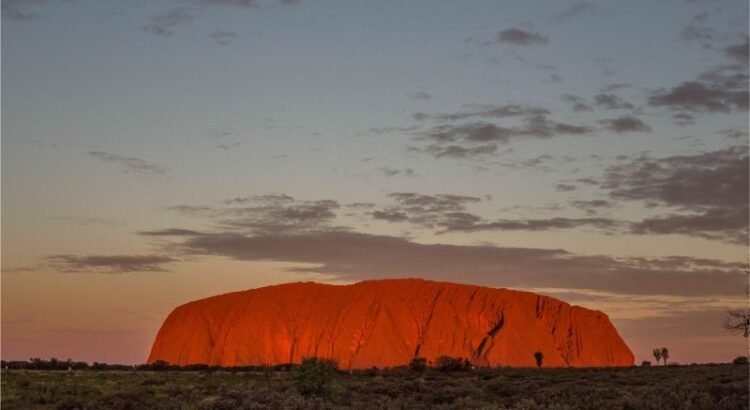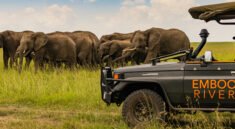
Australia’s heart does not beat in its coastal cities or turquoise oceans. It beats deep in the red, sunburnt interior — a land of ancient rocks, whispering winds, blazing skies, and sacred silence. This is the Outback, the wild and timeless soul of the continent. To stand upon its rust-colored soil, gaze into its endless horizons, and sleep beneath its starlit heavens is to understand something both eternal and raw — a connection to land, spirit, and self that words can barely contain.
A Land Carved By Time And Story
The Outback is not one place — it is a vast and varied landscape that stretches across much of central and western Australia. It is not defined by towns or borders but by feeling. The minute you enter it, you sense the shift. The land opens wide, the road runs straight into infinity, and the sky becomes a dominant presence, so vast it humbles you.
Eroded mountain ranges rise from the earth like petrified waves. Ancient gorges hide waterholes that have given life for millennia. Dust swirls in the afternoon heat. Spinifex grasses glow gold in the sun. Kangaroos leap through dry scrub. And in the distance, Uluru — the world’s greatest monolith — rises like a sacred heartbeat from the desert floor.
This land is old — unimaginably old. Some of its rocks are over 3 billion years in age. The stories of its people stretch back even further. To walk here is to walk through Deep Time.
The First Nations: Guardians Of The Dreaming
For over 60,000 years, Australia’s First Nations peoples have lived in deep spiritual relationship with the Outback. Their cultures are among the oldest continuous on Earth. They do not simply live on the land — they are part of it.
The concept of the Dreaming (or Tjukurpa, among the Anangu people of the Red Centre) is central. It is a way of seeing the world in which the past, present, and future are woven together by ancestral beings who shaped the land and continue to guide it. Every rock, tree, and animal is part of this spiritual fabric. Uluru is not just a geological marvel — it is a living ancestor. Every crack and cave holds story, law, and meaning.
To sit with an Aboriginal elder, to listen to their stories under a gum tree, is to be drawn into a universe far older and deeper than the one we normally inhabit. You begin to feel the Outback not just as scenery, but as song, story, and soul.
The Sacred Silence: Listening With The Heart
The Outback is not quiet in the way a library is quiet. Its silence is alive. It is the call of a distant hawk, the rustle of dry grass, the groan of wind through rock. It is the breath of the earth — subtle, vast, and full of mystery.
You don’t just hear silence here — you listen within it.
This silence has power. It strips away the noise of modern life. The emails, the traffic, the screens — all fall away. What remains is you, the land, and your own beating heart. Many travelers come here seeking adventure. Most leave with something far more valuable: clarity.
Beneath the stars and sand, the Outback asks nothing of you except presence. And in that presence, something shifts. You become more honest, more open. You remember what it means to simply be.
Uluru And Kata Tjuta: Standing In The Presence Of Sacredness
Nothing prepares you for your first glimpse of Uluru. Rising 348 meters from the desert floor, it commands attention not through grandeur but through spiritual gravity. Its color changes throughout the day — ochre at noon, deep red at sunset, and sometimes a glowing purple in twilight. It is as if it breathes.
Nearby, the rock domes of Kata Tjuta (The Olgas) form another sacred site — a place of legends and restricted secrets. These are not just places to photograph. They are places to feel, to respect, and to approach with humility.
Walking the Valley of the Winds trail at sunrise, with the morning breeze whispering through the red rocks, is one of the most humbling experiences on Earth. You are not just a visitor here. You are in ceremony, even if you don’t realize it.
Nights Beneath The Stars: A Celestial Awakening
If the Outback transforms your days, it transcends your nights. With virtually no light pollution, the sky becomes a cathedral of stars. The Milky Way stretches like a river of fire. Shooting stars race across the black. The Southern Cross hangs steady in the darkness, and planets glow with impossible brilliance.
In this stillness, camping becomes a sacred act. Lying in a swag (traditional canvas bedroll) under open sky, the galaxy your ceiling, you begin to comprehend your place in the cosmos. You are small, yes — but not insignificant. You are part of this ancient, breathing world.
Indigenous guides may point out celestial Dreaming stories — tales that mirror those etched in the rocks. The stars become more than points of light. They are guides, spirits, and reminders of our place in the circle of life.
Encounters With Wildlife: The Land’s Living Energy
The Outback is not empty — it is teeming with life, though you must learn how to see it. At dawn, mobs of kangaroos graze. At dusk, dingoes prowl the edges of bushland. Wedge-tailed eagles soar high, watching with predator eyes.
Even in the harshest desert, life persists. Thorny devils creep across hot sands. Lizards dart between rocks. Flocks of galahs and cockatoos flash pink and white against a cobalt sky. At night, the chirr of crickets and frogs replaces the daytime stillness.
Each animal holds meaning in Aboriginal culture — a totem, a teacher. To observe them is not just to admire, but to learn.
Bush Foods And Desert Feasts: Nourishment From The Land
The desert feeds those who know how to look. Aboriginal Australians have gathered bush foods for millennia — seeds, roots, berries, and insects. They know which plants heal, which sustain, which harm.
Modern tours now offer immersive bush tucker experiences. You might taste witchetty grubs, rich in protein and surprisingly creamy. You might try bush tomatoes, lemon myrtle, or smoked emu. Meals are often cooked over open fire, paired with damper (a type of bread), and served with the stories of the land.
These meals are not gourmet in the traditional sense — they are grounded, real, and deeply satisfying. They nourish body and spirit.
The Heat, The Dust, And The Soul’s Rebirth
The Outback is not an easy place. It is hot, often relentlessly so. Dust clings to everything. Flies swarm in the heat. Distances are vast. But this challenge is part of the transformation.
There is something liberating about surrendering to the elements — about sweating under the noonday sun, feeling your muscles ache from a long walk, drinking water as though it were gold. The comforts of modern life fade, and with them, your layers of stress.
What emerges is your essential self — resilient, raw, and deeply alive.
Meeting The People: Rugged Spirits And Quiet Wisdom
The Outback draws a special kind of person — wanderers, storytellers, artists, and keepers of memory. In remote towns like Alice Springs, Coober Pedy, or Birdsville, you’ll meet characters who defy stereotypes: poets who drive trucks, opal miners with PhDs, Aboriginal rangers who blend ancient and modern wisdom.
Conversations here are unhurried, rich, and real. You talk around fires, under stars, over billy tea. People speak not in sound bites but in stories.
Their connection to the land is palpable. And through them, you begin to understand what it means to belong to the Outback.
A Spiritual Pilgrimage
To travel through the Australian Outback is to undertake a kind of pilgrimage. Not to a temple or shrine — but to a way of being. It is a journey not outward, but inward.
Every mile of dusty road, every echo in the gorge, every spark in the night sky is a step into deeper presence. You feel the earth beneath your feet — red, cracked, honest. You feel the stars above your head — infinite, ancient, and pulsing with stories. You feel your heart — unarmored, open, and ready to listen.
You are no longer a tourist. You are a participant in something sacred.
Leaving, But Never Really
Eventually, you leave. The road curves back toward the coast. The desert recedes in the rearview. But it does not leave you.
The Outback stays — in your bones, in your dreams, in the new silence inside you. You will crave that night sky, that heat, that sense of scale. You will speak differently, walk slower, see deeper. You have touched something timeless — and been changed.
Because once you’ve felt the soul of Australia beneath its stars and sand, you realize you were never just traveling across land.
You were traveling back to yourself.




